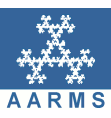 |
|
||||
[PDF]
- H. E. A. EDDY CAMPBELL, President, University of New Brunswick-Fredericton
Mathematics in Today's University [PDF] -
I will talk about the university and the situation in which we find ourselves this year, with some mention of research funding, particularly MITACS and NSERC. On the math side, I will argue that we need to see ourselves more clearly as part of the quantitative sciences (and engineering) and include CS, Stats, OR, etc., under this umbrella.
I will argue that outreach of various kinds is essential for our future success, and that we have to find ways and means to have some parts of our discipline aimed at solving today's problems in multi-disciplinary teams. There are certainly implications here for the education of our students, but I will leave these for the many critical discussions that will continue to take place in our community.
- GERDA DE VRIES, University of Alberta
Mathematics for multiple-scale modelling and emergent behaviour: case studies from biology [PDF] -
The role of mathematics in biology is to make sense of the complexity of our living world, to provide insight into mechanisms that may underlie observed phenomena. A significant challenge in modelling biological systems is to bridge the wide range of spatial and temporal scales on which biological processes operate.
In this talk, I will highlight mathematical approaches that deal with multiple scales, and provide methods to understand the emergence of properties of aggregated systems from the properties of its constituents.
Examples of application are taken from my research, ranging from the investigation of oscillations that play important roles in physiological phenomena such as breathing and the control of blood sugar to the investigation of spatial animal group patterns that result from different communication mechanisms.
- HENRI MOSCOVICI, The Ohio State University, Columbus, OH 43210
Hopf algebras and transverse characteristic classes [PDF] -
Hopf algebras and their Hopf cyclic cohomology emerged as a geometric tool in the work of A. Connes and myself computing the local index theorem for transversely (hypo)elliptic operators on foliations. In this talk I will explain how they allow to express the characteristic classes of a foliation solely in terms of the transverse holonomy data, without resorting to the ambient manifold.
I will then discuss extensions and refinements of these results, obtained in recent joint work with B. Rangipour, which cover all classical types of (infinite primitive Cartan-Lie) holonomy pseudogroups.
- IDUN REITEN, NTNU, Alfred Getz v. 1, 7491 Trondheim, Norway
Categorification of quiver mutation [PDF] -
Mutation of quivers (i.e., directed graphs) is an essential ingredient in the definition of the influential theory of cluster algebras introduced by Fomin and Zelevinsky about 10 years ago. One approach to the study of cluster algebras has been to "categorify" the main concepts in their definition. In this lecture we illustrate the idea of categorification through categorification of quiver mutation, starting with the special case of mutation at the vertices called sinks,from work by Gelfand, Bernstein and Ponomarev from around 1970.
- KRISTIN SCHLEICH, University of British Columbia
Topological censorship and beyond: black holes and singularities from topological structures [PDF] -
The singularity theorems of the 1960s provided deep insight into the nature of general relativity; spacetimes satisfying a general set of conditions collapse to form a singularity. In particular, spacetimes with nontrivial fundamental group collapse.
Furthermore, the topological censorship theorem implies the existence of eternal black holes for spacetimes with nontrivial fundamental group. However neither it nor the singularity theorems indicate whether or not higher dimensional spacetimes with trivial fundamental group but containing other nontrivial topological structure collapse. Recent work shows that such collapse occurs for certain such structures; spacetimes in 5 or more dimensions with trivial fundamental group but with topological structures with, for example, non-zero A-hat genera must be singular. This talk will discuss this and other work toward this issue and its implications for classical relativity in higher dimensions.
- GUNTHER UHLMANN, University of Washington, Seattle, WA 98195, USA
Cloaking, Transformation Optics and Inverse Problems [PDF] -
We describe recent theoretical and experimental progress on making objects invisible to detection by electromagnetic waves, acoustic waves and quantum waves. For the case of electromagnetic waves, Maxwell's equations have transformation laws that allow for design of electromagnetic materials that steer light around a hidden region, returning it to its original path on the far side. Not only would observers be unaware of the contents of the hidden region, they would not even be aware that something was being hidden. The object, which would have no shadow, is said to be cloaked. We recount the recent history of the subject and discuss some of the mathematical issues involved.





